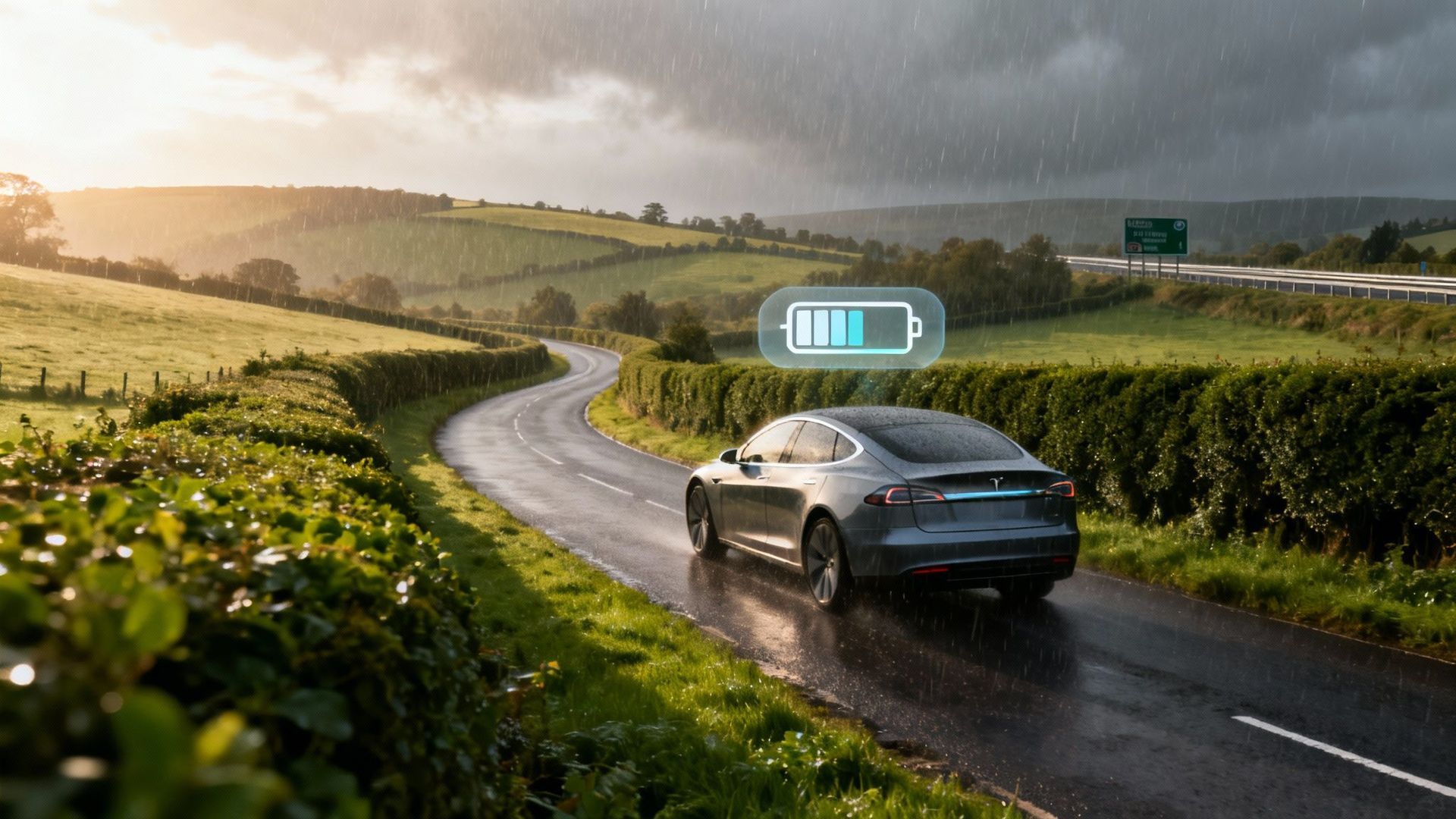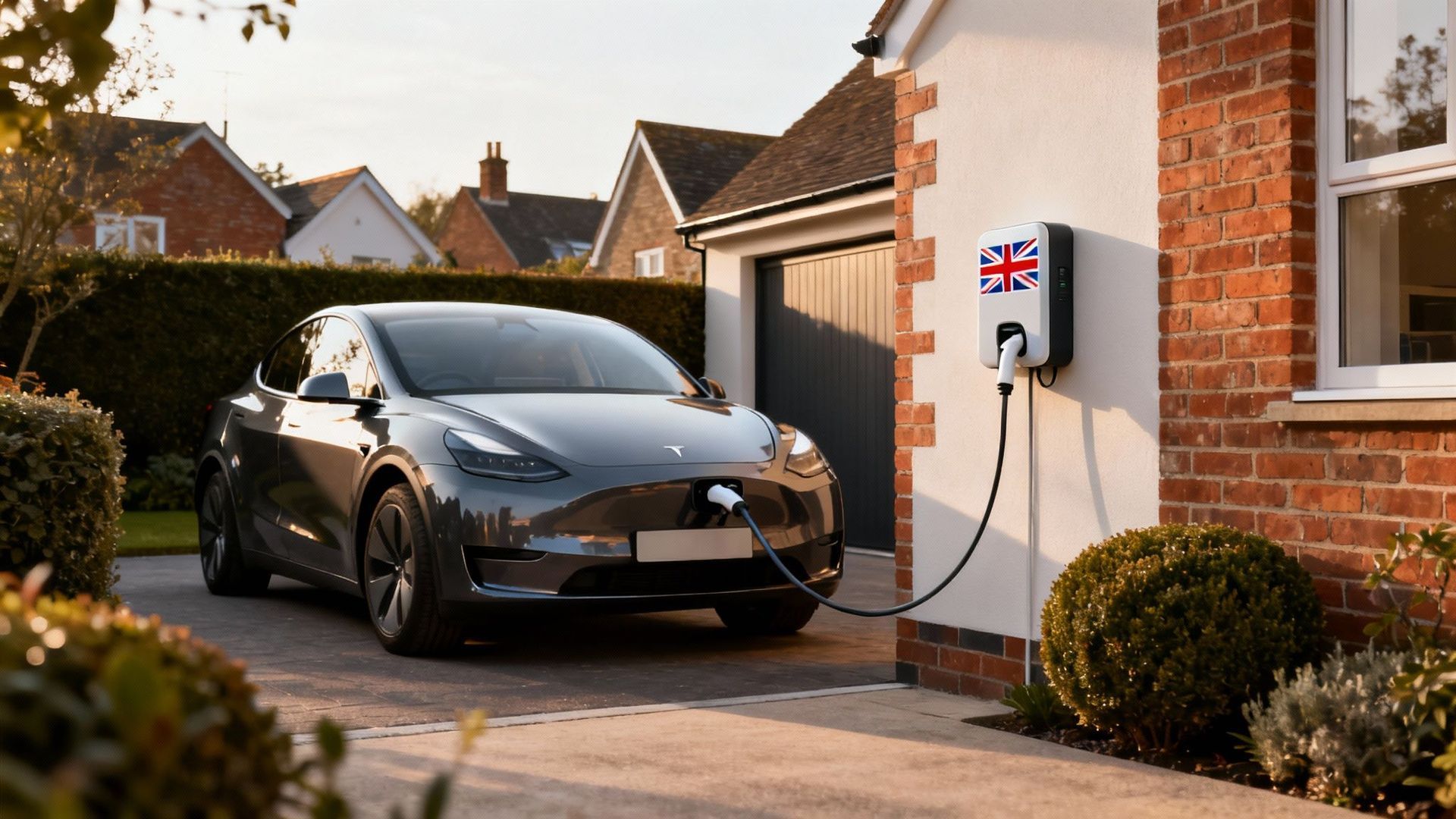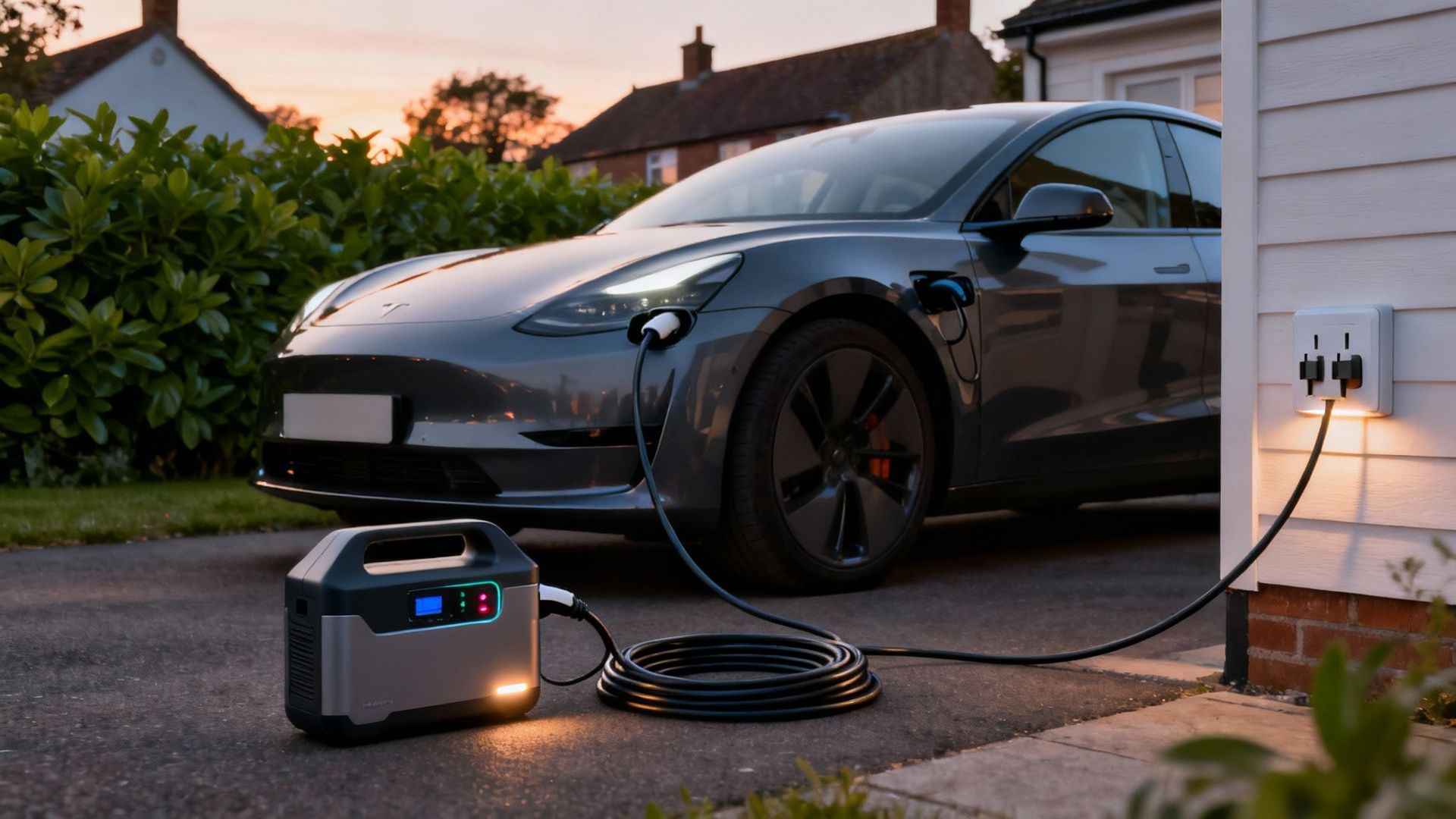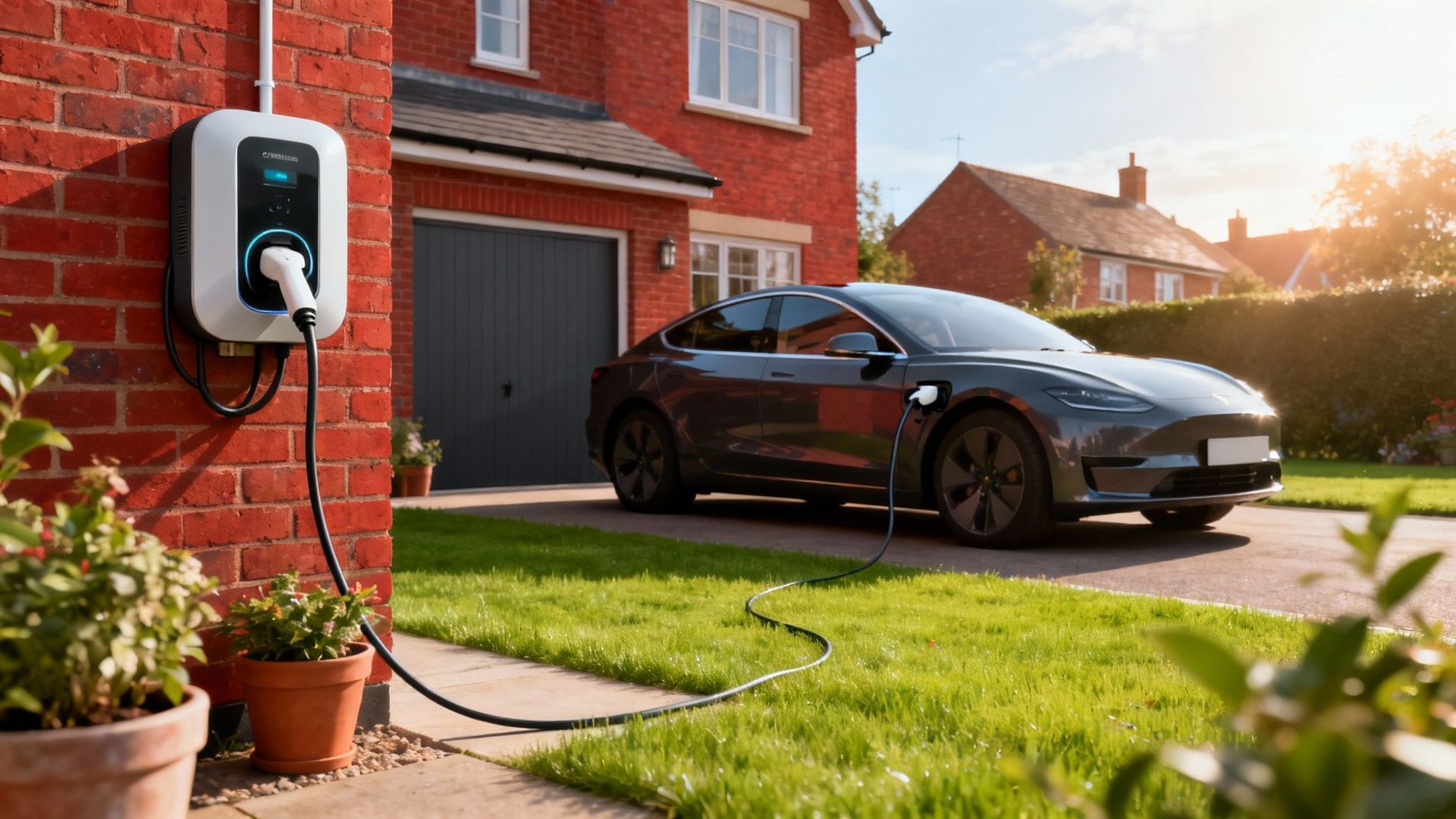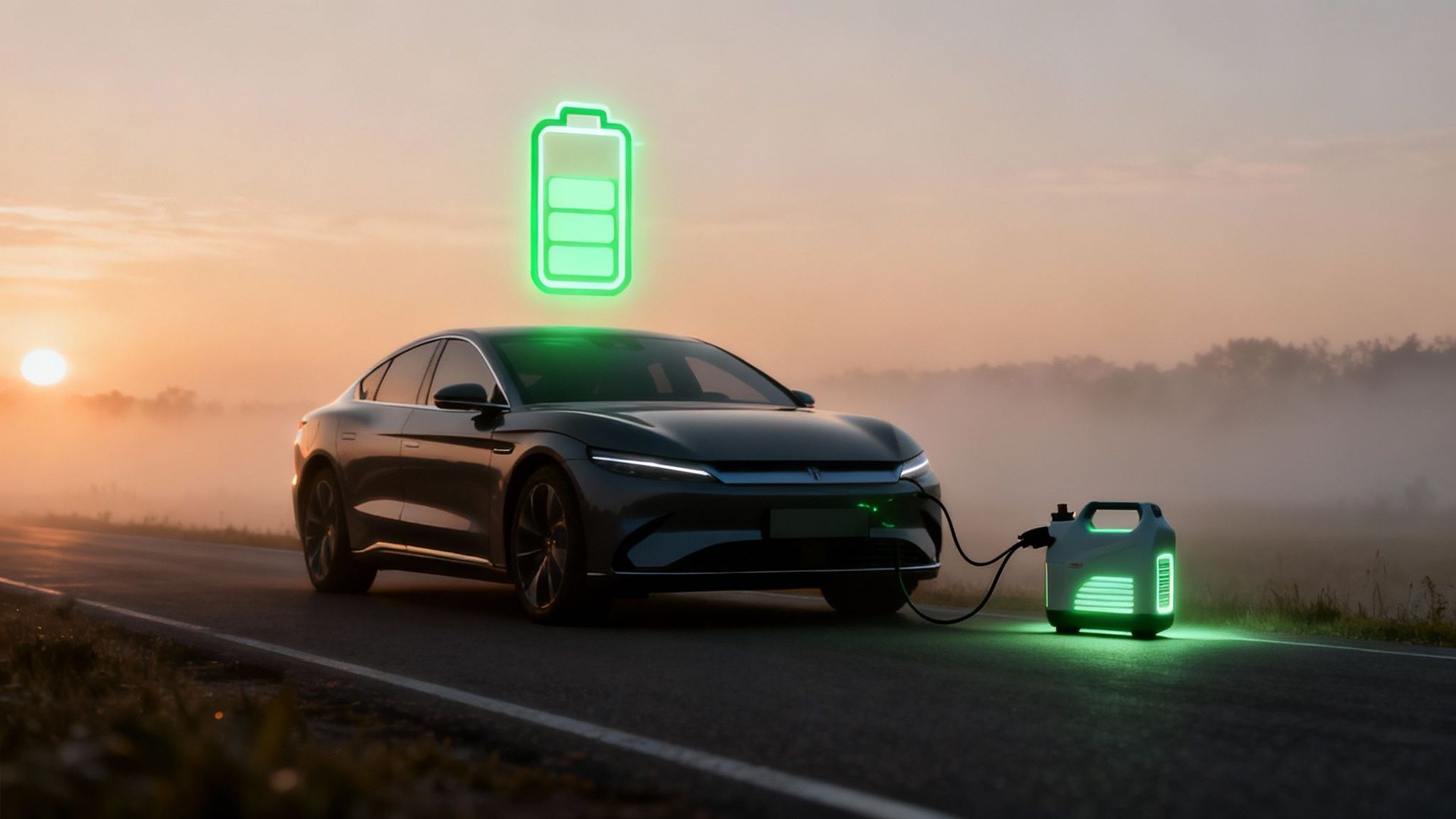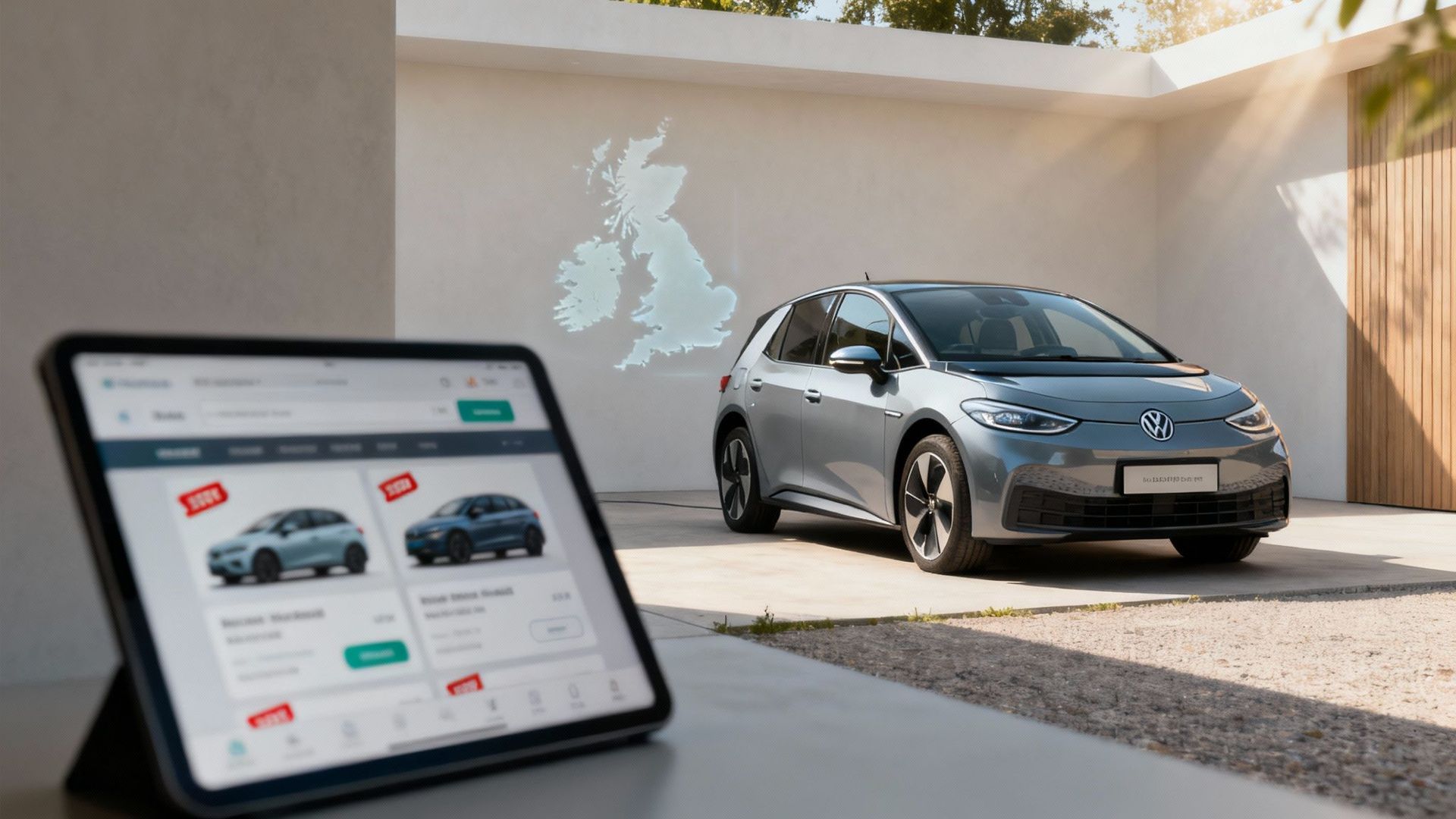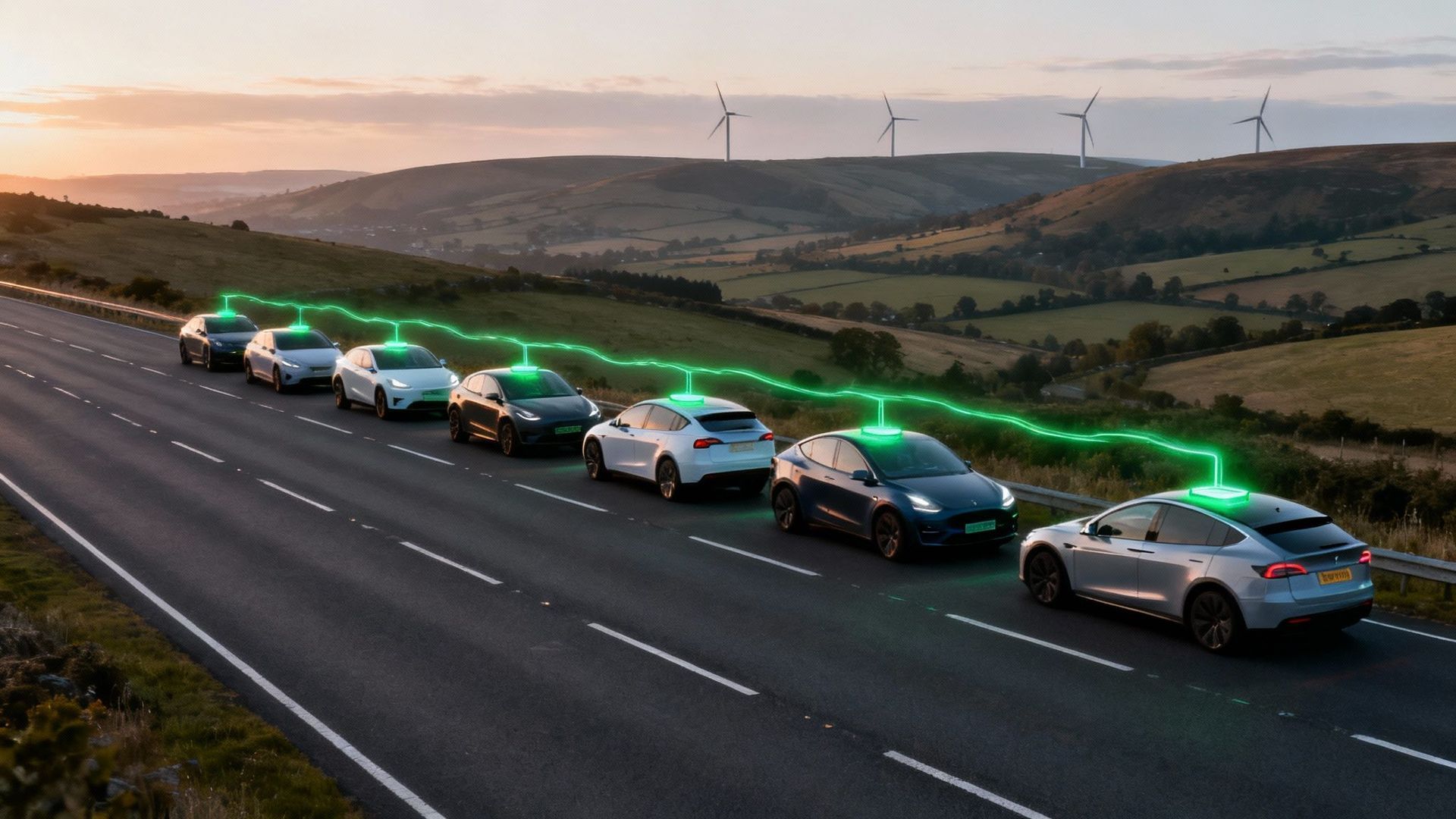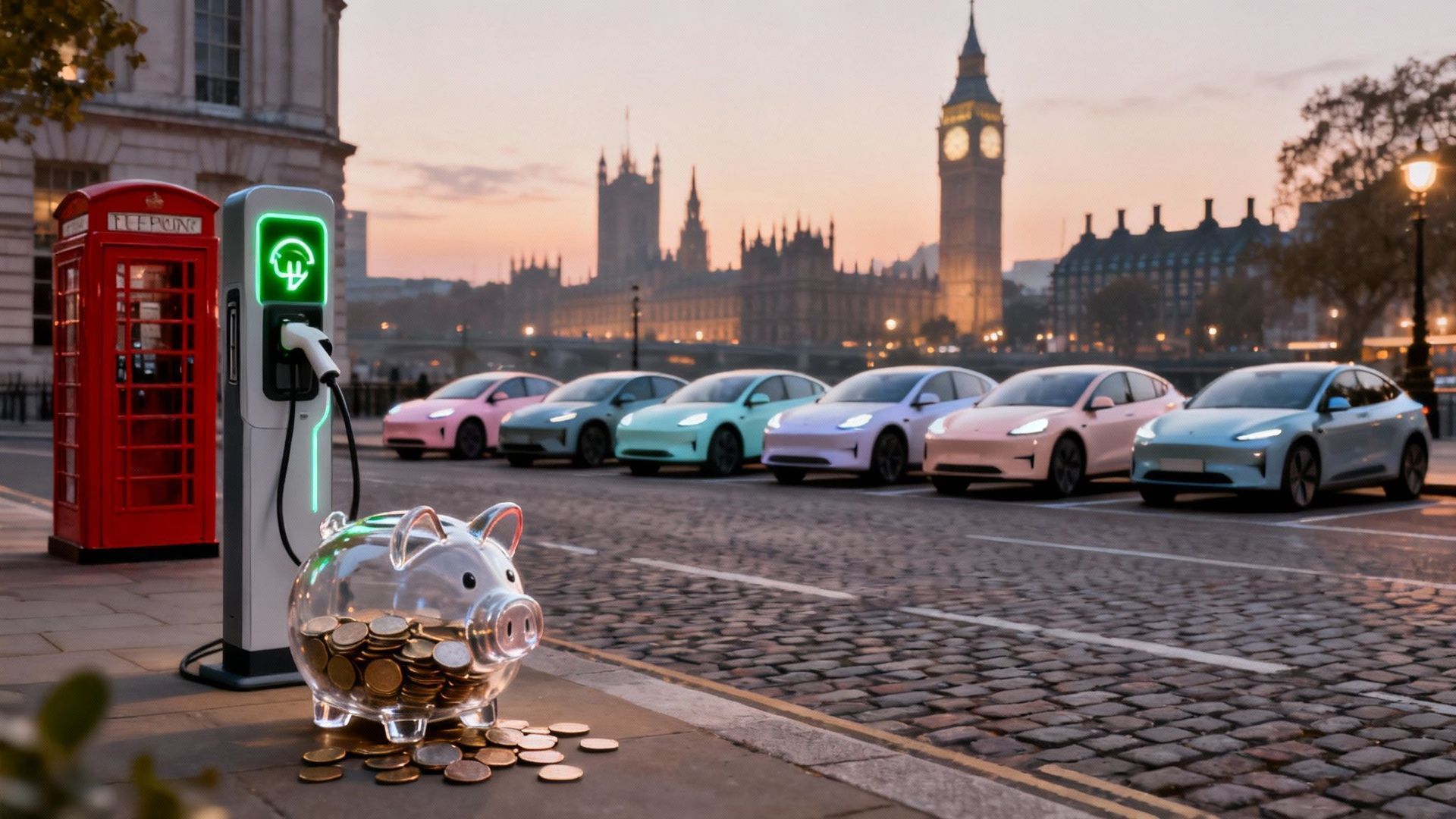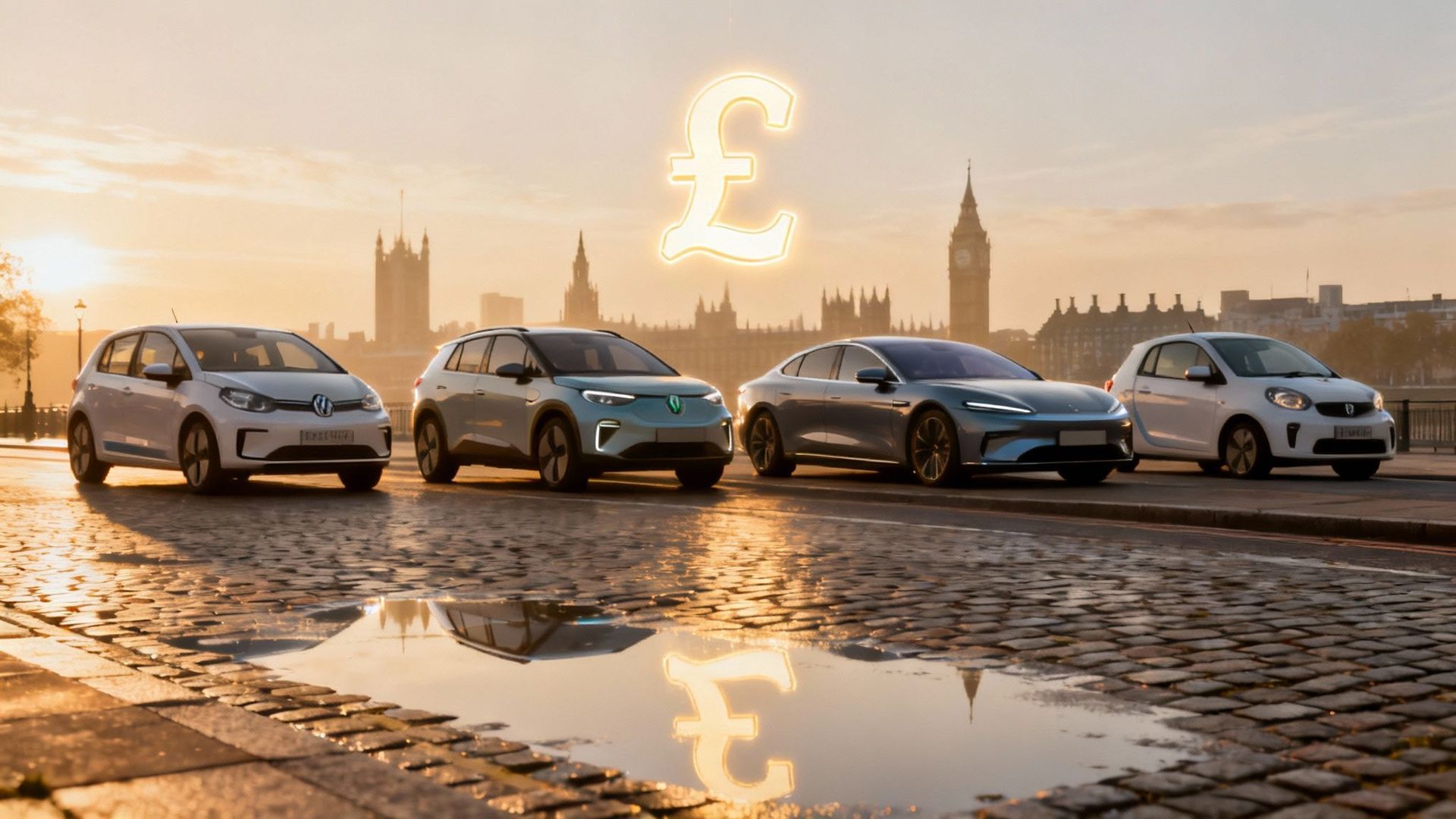So, Your Electric Car's Maintenance Bill Is Cheaper? Pull the Other One
Let's cut the flannel: when it comes to keeping your motor on the road, electric vehicles are scandalously cheaper to maintain than their petrol or diesel brethren. We’re not talking about saving a few quid on an oil filter here and there. The reality is potential savings of thousands of pounds over just a few years of ownership.
Putting Your Wallet on a Low-Carbon Diet
It’s time to forget everything you know about those annual servicing bills that make your bum squeak. The chatter around EV maintenance costs isn't just hype from bearded hipsters in Shoreditch; it's a tangible, bank-balance-boosting reality for drivers across the UK.
Think about it. An EV has far fewer moving parts under the bonnet. There’s no engine oil to change, no spark plugs to replace, and no labyrinthine exhaust system just waiting to rust through at the first sight of a damp Tuesday. With less to go wrong, there's simply less to pay for.
The Real Cost Breakdown (No, Really)
While the initial price tag of an EV might still be a hurdle for some, the long-term savings really do stack up. A 2025 analysis found that over five years, EV maintenance typically costs between £1,000 and £1,500 . In stark contrast, a comparable petrol car could easily fleece you for £3,000 to £4,000 over the same period.
That's a potential saving of up to 67% . A figure like that suddenly makes the upfront investment look a lot more palatable.
To put this into perspective, let's compare the numbers side-by-side.
Five-Year Maintenance Costs: EV vs Petrol Car
The table below gives a clear snapshot of what you can expect to spend on servicing and maintenance over a typical five-year ownership period. Prepare to be smug.
| Vehicle Type | Average 5-Year Maintenance Cost | Potential Savings with EV |
|---|---|---|
| Electric Vehicle (EV) | £1,000 - £1,500 | - |
| Petrol Vehicle | £3,000 - £4,000 | £2,000 - £2,500 |
As you can see, the difference is significant. Choosing an EV means you could be holding onto an extra couple of thousand quid that would have otherwise gone to your local garage.
So, where does the money actually go when an EV does need a bit of TLC? This image gives a great overview of the main areas of expenditure.

The battery is often seen as the elephant in the room, but we'll tackle the myths around that later on. The main thing to notice is how little of the cost goes towards the traditional, greasy-bits servicing that plagues petrol and diesel cars. If you're keen to explore the numbers further, you can learn more about the real cost of owning an EV compared to petrol cars in our dedicated guide.
In essence, an EV service is more like a health check-up than major surgery. Technicians focus on software, brakes, tyres, and battery health, not replacing a warren of oily, mechanical parts destined to conk out.
Why Your EV Avoids Expensive Garage Bills
So, what’s the big secret? How do electric cars manage to dodge those eye-watering annual garage bills that we’ve all come to dread? It’s not black magic, just brilliantly simple engineering. The real reason you'll save a bundle on maintenance is down to what your EV doesn't have under the bonnet.
Think about a standard petrol or diesel engine for a moment. It's a complex, greasy masterpiece of controlled explosions, with roughly 2,000 moving parts . You've got pistons, valves, spark plugs, fuel injectors, clutches, starter motors, and an exhaust system that seems designed to rust away at the mere sight of a British winter. Every single one of those parts needs checking, cleaning, or eventually replacing.
Now, an EV motor? It has about 20 moving parts . Let that sink in for a second. It's a clean, efficient, and almost silent powerhouse. There's no oil to change, no filters to clog, and no exhaust fumes to worry about. It’s less like a car engine and more like a high-end appliance; you just switch it on, and it works.

The Ghost Parts of Petrol Cars
Switching to an EV means you get to wave a final, cheerful goodbye to a whole list of common garage-bill culprits. These are the parts that simply don't exist on an electric car, which means they can never break and demand your hard-earned cash.
- Exhaust Systems: Notorious for rust, rattles, and failing an MOT. Gone.
- Clutches & Gearboxes: Incredibly complex, prone to wear, and painfully expensive to fix. Not your problem anymore.
- Starter Motors & Alternators: Two classic failure points that can leave you stranded. Eradicated.
- Fuel Pumps & Injectors: Clogging and failing is their speciality. Thankfully, irrelevant.
- Oil, Fuel, and Air Filters: The endless cycle of replacement finally stops here.
This mechanical simplicity is the foundation of the savings. It’s why inspecting a second-hand electric car is a fundamentally different (and much shorter) process. If you're looking at a used model, it’s worth reading our guide on the top things to look for when inspecting a used EV to see just how different the checklist is.
The Genius of Regenerative Braking
But wait, there’s more. EVs have another clever trick that saves you even more money: regenerative braking . It might sound a bit technical, but the idea is beautifully simple.
When you take your foot off the accelerator in a petrol car, the car just coasts. In an EV, the motor essentially runs in reverse, creating resistance that slows the car down. As it does this, it captures the kinetic energy that would normally be wasted as heat from the brakes and sends it straight back to the battery, giving you a little top-up of range.
The real bonus here? Because the motor is doing a huge chunk of the braking work, your actual brake pads and discs have a much easier life. They wear down far more slowly, which means you'll be replacing them much less often than you would in a conventional car. Less wear, less spend. Simple.
A Realistic Breakdown of EV Servicing Costs
So, your EV doesn't need an oil change, and you won't be seeing any expensive, smoky clouds coming from a failing engine. But that doesn’t mean you can just drive it forever without a thought. What exactly are you paying for when you take it in for its annual service? The good news is, it’s much more of a quick health check than a major operation.

Unlike the greasy, part-swapping ritual of a traditional car service, an EV check-up is a far more civilised affair. A technician will plug your car in for a diagnostic scan, checking the health of the high-voltage battery and making sure all the software is bang up to date. It’s less about spanners and more about laptops.
From there, they’ll look at the few mechanical bits that remain. This means inspecting the battery's cooling system, checking your brake fluid, rotating the tyres for even wear, and maybe popping in a new cabin filter so you’re not breathing in last week’s traffic fumes. It's a remarkably short to-do list.
What the Numbers Say
This simplified process translates directly into real savings on your annual bill. A recent UK study crunched the numbers on 30 EV models and their petrol-powered equivalents, confirming what EV drivers have known for years. The average yearly service for an electric car came in at just £246 , while petrol or diesel owners were forking out an average of £614 .
That's a massive 60% reduction in electric vehicle maintenance costs. You can read the full report on EV running costs to see the detailed breakdown for yourself.
This isn't some niche finding, either; it's the reality for British drivers up and down the country. Lower servicing costs aren't a myth peddled by EV fanatics; they’re a quantifiable, year-on-year financial advantage.
A Typical EV Service Checklist
So, what does that £246 actually get you? While it varies a bit between manufacturers, the core tasks are refreshingly straightforward. They focus on safety and efficiency rather than replacing a long list of knackered engine parts.
A standard service will almost always include:
- Battery Health Check: A full diagnostic report on your battery's condition and performance.
- Brake Inspection: A look at the brake pads, discs, and fluid levels (these last much longer on an EV thanks to regenerative braking).
- Tyre Rotation and Inspection: Making sure your tyres are wearing evenly and are in good nick.
- Cooling System Check: Ensuring the system that keeps your battery happy is leak-free and topped up.
- Software Updates: Installing any updates from the manufacturer to improve performance or add new features.
Essentially, you're paying for an expert to confirm that everything is working as it should, not to replace a list of parts that are designed to wear out. It’s a fundamental shift from reactive, expensive repairs to proactive, affordable health checks.
Debunking the Myth of the £10,000 Battery Bill
Ah, the battery. It’s the one topic every pub bore and EV sceptic loves to bring up, usually with a grim warning about a five-figure bill lurking just around the corner. Let’s be honest, the idea of a catastrophic battery failure is the biggest bogeyman in the world of electric vehicles.
But in reality? That fear is about as current as a dial-up modem.
For the vast majority of owners, an EV battery is a reliable, long-lasting workhorse, not a ticking financial time bomb. Think of it like the battery in your phone, but on a much grander, more robust, and intelligently managed scale. It's built to last for years of charging, handle whatever the British weather throws at it, and endure the daily grind.
Warranties That Actually Mean Something
Manufacturers get it. They know battery anxiety is a major hurdle for people thinking of making the switch. That's why they back their tech with some seriously hefty warranties.
And these aren't just flimsy promises. Most EV battery warranties in the UK will cover you for:
- A minimum of eight years.
- At least 100,000 miles of driving.
The crucial part is what this warranty guarantees. It isn't just for a complete failure. It’s a promise that the battery will hold a certain percentage of its original capacity (usually 70% ) over that period. If it degrades faster than that, the manufacturer has to put it right.
This performance guarantee is the key. You're protected against significant, premature degradation—which is the real-world concern, not some sudden, catastrophic meltdown. It’s a safety net that makes the fear of a huge bill largely unfounded for the first decade of the car's life.
What’s the Real-World Lifespan?
So, what happens after the warranty runs out? Does the battery just give up the ghost? Not at all.
Real-world data shows that modern EV batteries are holding up remarkably well. It’s not unusual to see EVs sail past 150,000 miles with well over 80-90% of their original capacity still intact.
Degradation is a real thing, of course, but it’s a slow, gradual process, not a sudden cliff-edge drop. The sophisticated battery management systems in today's EVs are brilliant at protecting the cells from the stresses that cause damage. Understanding this is vital, especially if you're looking at a second-hand model. You can dive deeper into the truth about battery health reports on used EVs to see how to properly assess a pre-loved electric car.
How EV Savings Grow Stronger Over Time
The financial perks of driving an EV aren't just a honeymoon phase; they’re a long-term benefit that genuinely gets better with age. While the initial savings on fuel and servicing are a great start, the real magic happens as the years and miles start to pile on. This is where the gap between EV maintenance and the bills for an old petrol car widens into a chasm.
Think of it like this: a petrol car ages like a rock star. The first few years are great, but eventually, the hard living catches up. Parts start to fail, things begin to leak, and it suddenly needs expensive surgery—a new cambelt, a water pump, or a clutch. It’s a noisy, expensive, and frankly undignified process of mechanical decay.

Your EV, on the other hand, ages more like a fine wine. It just keeps humming along, quietly and efficiently, without all the drama of mechanical meltdowns.
The Divergence Point
For the first couple of years, you'll see a clear but modest saving. But it's from year three onwards that the financial paths really start to diverge. This is typically when a petrol car’s warranty runs out and its mechanical parts start throwing in the towel. That first big post-warranty service often comes with a worrying list of ‘advisories’ that soon become expensive necessities.
Meanwhile, your EV is likely just having its tyres checked and its cabin filter swapped. There’s no big, scary £1,000 bill for a new exhaust system or a clogged-up diesel particulate filter. These savings aren't just theoretical; they're a real-world reality you’ll see in your bank balance, year after year.
This growing advantage has been well-documented. An independent comparison published in 2025 shows exactly how these savings accelerate over time. Their analysis found that while EVs are already 17-18% cheaper to service in the first three years, this advantage balloons to between 22% and 28% from years three to five. You can read the full analysis on petrol vs electric servicing costs to see the detailed figures for yourself.
The Long-Term Financial Horizon
Looking beyond the five-year mark, the financial case becomes even more compelling. By the time a petrol car hits 100,000 miles, it’s often on its second clutch, third set of brake discs, and who knows what else. The EV equivalent? It’s probably just had its first major brake service, thanks to regenerative braking doing most of the work.
When you calculate the total cost of ownership over a decade, the EV doesn't just win; it laps the petrol car while sipping a smug, metaphorical cup of tea. It's an investment that pays ever-increasing dividends in avoided garage bills.
This long-term reliability completely changes the ownership experience. Instead of dreading the annual MOT and service, you can approach it calmly, knowing that a financial bombshell is extremely unlikely. It’s about more than just money; it’s about genuine peace of mind.
Got More Questions About EV Maintenance?
Alright, let's dive into a few of the common questions we hear all the time. This is the quick-fire round to clear up any final worries you might have about keeping an electric car on the road.
Do I Need a Specialist Garage to Service My EV?
For the big stuff, it’s a very smart move. While any decent local garage can handle your tyres, brakes, or suspension, the high-voltage systems are a different kettle of fish entirely. You want someone who knows what they’re doing.
Think of it this way: you wouldn't ask your GP to perform heart surgery. Most main dealers and a growing number of forward-thinking independent garages now have properly trained technicians with the right qualifications. It’s worth seeking them out for that peace of mind.
Are EV Tyres Really More Expensive?
They can be, but there's a good reason for it. EVs are heavy, and that instant torque from the electric motor puts a lot of strain on the rubber. It's a combination that can wear out standard tyres surprisingly quickly.
To counter this, many EVs are fitted with special tyres built to handle the extra weight, reduce road noise, and improve range. Yes, they might cost a bit more upfront, but the price gap is shrinking all the time. When you factor in the huge savings you're making elsewhere, it's a small price to pay.
The bottom line is that specialist EV tyres are a sensible, justified expense. Any slightly higher cost is completely overshadowed by the massive savings on fuel and servicing, making it a non-issue for most owners.
What Happens If My Battery Fails After the Warranty Ends?
First off, don't panic. Complete battery failure in a modern EV is incredibly rare—far less common than a catastrophic engine failure in a petrol or diesel car. Most batteries are designed to last the life of the vehicle and then some.
But let's say the worst happens and you're outside the typical 8-year warranty . It doesn't automatically mean a huge bill for a brand-new battery. A growing number of specialists can now diagnose and replace individual faulty cells or modules within the pack. This kind of targeted repair is a fraction of the cost of a full replacement, and it's making the old 'all-or-nothing' scenario a thing of the past.
At VoltsMonster , our job is to cut through the jargon and give you the straight-talking advice you need. From busting myths to giving honest reviews, you'll find everything you need to confidently navigate the world of electric cars at VoltsMonster.com.

